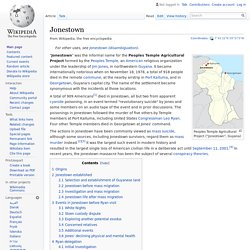

Op-Art: Like it or Unfriend It - Graphic. E=mc²: Einstein's Big Idea (NOVA) Puyi. Aisin-Gioro Puyi (Chinese: 愛新覺羅·溥儀; pinyin: Àixīnjuéluó Pǔyí; Wade–Giles: Ai4-hsin1-chüeh2-lo2 P'u3-i2; 7 February 1906 – 17 October 1967), of the Manchu Aisin Gioro clan, commonly known mononymously as Puyi (Pu-yi;[1] Chinese: 溥儀; pinyin: Pǔyí; Wade–Giles: P'u3-i2), was the last Emperor of China and the twelfth and final ruler of the Qing Dynasty.
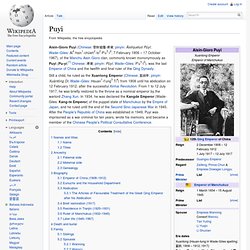
Names and titles[edit] Name[edit] Puyi's name is romanised in English as either "Puyi" or "Pu-yi". Typhoid Mary. Mary Mallon (September 23, 1869 – November 11, 1938), better known as Typhoid Mary, was the first person in the United States identified as an asymptomatic carrier of the pathogen associated with typhoid fever.

She was presumed to have infected some 49 people, three of whom died, over the course of her career as a cook.[1] She was twice forcibly isolated by public health authorities and died after a total of nearly three decades in isolation. Early life[edit] Mary Mallon was born in 1869 in Cookstown, County Tyrone, Ireland (now Northern Ireland). She emigrated from Ireland to the United States in 1884. [citation needed] Career[edit] In 1906, she took a position in Oyster Bay, Long Island, and within two weeks ten of eleven family members were hospitalized with typhoid. Investigation[edit] In late 1906, one family hired a typhoid researcher named George Soper to investigate. "It was found that the family changed cooks on August 4. First quarantine (1907–1910)[edit] Eventually, Dr. SAVAK. SAVAK (Persian: ساواک, short for سازمان اطلاعات و امنیت کشور Sāzemān-e Ettelā'āt va Amniyat-e Keshvar, Organization of Intelligence and National Security) was the secret police, domestic security and intelligence service established by Iran's Mohammad Reza Shah with the help of the United States' Central Intelligence Agency (the CIA).[1] SAVAK operated from 1957 to 1979, when the Pahlavi dynasty was overthrown.
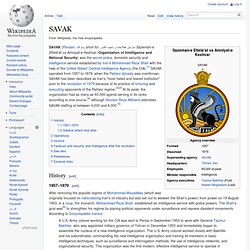
SAVAK has been described as Iran's "most hated and feared institution" prior to the revolution of 1979 because of its practice of torturing and executing opponents of the Pahlavi regime.[2][3] At its peak, the organization had as many as 60,000 agents serving in its ranks according to one source,[4] although Gholam Reza Afkhami estimates SAVAK staffing at between 4,000 and 6,000.[5] History[edit] 1957–1970[edit] A U.S. Polish parliament (expression) "Polish parliament" (Swedish and Norwegian: Polsk riksdag; Danish: Polsk rigsdag; German: Polnischer Reichstag; Dutch: Poolse landdag) is an expression referring to the historical Polish parliaments (Sejm walny).[1] It implies chaos and general disorder, and that no real decision can be reached during sessions.
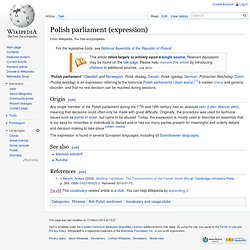
Any single member of the Polish parliament during the 17th and 18th century had an absolute veto (Latin: liberum veto), meaning that decisions could often only be made with great difficulty. Originally, the procedure was used for technical issues such as points of order, but came to be abused. Today, the expression is mostly used to describe an assembly that is too easy for minorities or individuals to disrupt and/or has too many parties present for meaningful and orderly debate and decision-making to take place. Holocene extinction. Operation Barclay. Operation Barclay was a World War II deception by the Allies in support of Operation Husky, the Allied invasion of Sicily in July 1943.

The goal was to deceive the Axis powers as to the location of the Allies' assault across the Mediterranean and to divert the Axis military commands attention and resources. Operation Barclay used bogus troop movements, radio traffic, recruitment of Greek interpreters, and acquisition of Greek maps to indicate an invasion through the Balkans.[1] Operation Fortitude. Five Elders. In Southern Chinese folklore, the Five Elders of Shaolin (Chinese: 少林五祖; Mandarin Pinyin: Shàolín wǔ zǔ; Jyutping: Siu3 lam4 ng5 zou2) are the survivors of one of the destructions of the Shaolin temple by LianZong Wang Qing Dynasty, variously said to have taken place in 1647, in 1674 or in 1732.

The original Shaolin Monastery was built on the north side of Shaoshi Mountain, the central peak of Mount Song, one of the Sacred Mountains of China, located in the Henan Province, by Emperor Xiaowen of the Northern Wei Dynasty in 477. At various times throughout history, the monastery has been destroyed (burned down) for political reasons, and rebuilt many times.[1] It is said that five Shaolin temples existed in various locations throughout Chinese history, although all 5 were rarely active at the same time.[2][3] The Five Elders of Shaolin[edit] Within many martial arts circles, these original Five Elders of Shaolin are said to be.
Abimael Guzmán. Manuel Rubén Abimael Guzmán Reynoso ( pronunciation ah-bee-mah-EHL gooss-MAHN;[needs IPA] born 3 December 1934), also known by the nom de guerre Comrade Gonzalo (Spanish: Camarada Gonzalo), a former professor of philosophy, was the leader of the Shining Path during the Maoist insurgency known as the internal conflict in Peru.
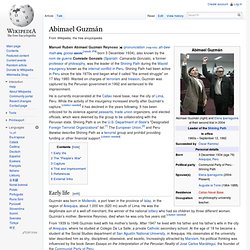
Shining Path had been active in Peru since the late 1970s and began what it called "the armed struggle" on 17 May 1980. Wanted on charges of terrorism and treason, Guzmán was captured by the Peruvian government in 1992 and sentenced to life imprisonment. He is currently incarcerated at the Callao naval base, near the city of Lima, Peru. Shining Path. Widely condemned for its brutality,[3][4] including violence deployed against peasants, trade union organizers, popularly elected officials and the general civilian population,[5] the Shining Path is classified by the Peruvian government, the U.S., the European Union, and Canada as a terrorist organization.[6][7][8] Since the capture of its leader Abimael Guzmán in 1992, the Shining Path has declined in activity.[9] Certain factions of the Shining Path now claim to fight in order to force the government to reach a peace treaty with the rebels.

Similar to militant groups in Colombia, some factions of the Shining Path have functioned as a highly efficient cocaine-smuggling operation, with an ostensibly paternalistic relationship to villagers.[10] Name[edit] The common name of this group, Shining Path, distinguishes it from several other Peruvian communist parties with similar names (see Communism in Peru). Jonestown. Coordinates: Jonestown Georgetown Kaituma Peoples Temple Agricultural Project ("Jonestown", Guyana)
